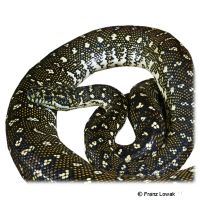Diamond Python (Morelia spilota spilota)
| Diamond Python Morelia spilota spilota | |
|---|---|
| Name | Diamond Python |
| Name Lat. | Morelia spilota spilota |
| Family | Pythons |
| Family lat. | Pythonidae |
| Order | Scaled Reptiles |
| Order lat. | Squamata |
| Origin | Australia |
| Habitat | Forests, shrubland |
| Diet | Small mammals |
| Humidity | 60-80 % |
| Behavior | Nocturnal, peaceful |
| Keeping | Individual, pair, harem |
| Care Level | Moderate |
| Reproduction | Oviparous |
| Housing | Semi-humid terrarium |
| Life Span | 15-20 years |
| Protection | CITES Appendix II; EU Annex B |
| Metric Units | |
| Size | 200 cm |
| Temperature | 26-28 °C |
| Temperature Local | 30-35 °C |
| Housing Size | 150 x 100 x 200 cm |
| US Units | |
| Size | 79" |
| Temperature | 79-82 °F |
| Temperature Local | 86-95 °F |
| Housing Size | 60" x 40" x 80" |
Distribution and habitat
Crepuscular and nocturnal, semi-arboricolous diamond pythons are native to New South Wales, in eastern Australia, where they live in coastal rainforests and savannas, as well as rocky areas. During the day they usually keep hidden in caves and hollow trees.
Maintenance
Minimum dimensions for the terrarium, according to the size and number of animals:
| 1-2 animals | 0,75KL x 0,5KL x 1KL (L x W x H) |
Body length (KL) is measured on the largest animal. For each additional animal the floor space should be increased by 20%. A terrarium of e.g. L 150 x W 100 x H 200 cm is recommended, which should be placed in a quiet and vibration-free place.
They need a terrarium structured with roots, branched climbing branches and caves (hiding places and privacy screens), a moisture-retaining substrate, e.g. of bark mulch-soil-peat mixture, foliage and sphagnum moss, as well as a large, easy-to-clean water basin (approx. 1/4 of the floor area) for drinking and bathing. Half of the substrate must be kept slightly moist at all times. Once a day, preferably in the evening, the inside of the terrarium should be finely sprayed with water (humidity), but a rain or mist system is better.
| Temp. day: 26-28 °C | Temp. night: 20-22 °C | Temp. local: up to 35 °C | Humidity: 60-80 |
Thermostatically controlled floor heating is recommended. Lighting duration must be 12-14 hrs. depending on the season. Daylight fluorescent tubes are ideal.
Diet
According to their size, they feed on mice, rats, guinea pigs and other rodents, as well as chicks and small pigeons. After acclimation, they often succeed in switching to dead food animals. Juveniles should be offered food every 8-10 days and adults every 14-20 days, with occasional periods of fasting (e.g., skipping a feeding). If the snake is disturbed after feeding, this may result in vomiting of the prey. Generally, it is better to offer several small feeders, rather than one large one. If it does not eat for a long period of time, both the timing and the food should be varied. It is important to fortify the food animals with vitamins and minerals. Since the snake could be injured by live rodents, it should not be left unattended with them.
Reproduction and breeding
Probing by the veterinarian is the only reliable method of sex determination. The female lays 15-20 eggs and incubates them. The incubation period is 60-70 days at a temperature of about 30 °C. Only after the first molt (2-4 weeks) the 40-45 cm long young start to eat (e.g. nest young mice)
The life expectancy can be 15-20 years.
Species protection
The animal population must be reported to the competent authority in writing immediately after the start of keeping. Your pet store will be happy to provide you with further information.
Protection of species: WA Appendix II; EU Appendix B. The proof of purchase is the required proof of origin for the animal. Please keep it safe!
Important
They have a nearly black base coloration with yellow or white diamond-shaped spots or dots. Males are very territorial during the mating season, so only one male should be kept in the terrarium at a time
If the air temperature in the terrarium is lower than the temperature in the water tank, there is a risk of respiratory infection
A resting period of 2-3 months at a temperature reduced by 2-3 °C is recommended
Always have snake hooks, protective gloves and cold water ready when handling.
The terrarium must have good ventilation without drafts and meet the species-specific needs. Measuring devices such as thermometers, hygrometers, etc. are necessary. The lighting has to correspond to the species-specific day-night rhythm and has to be placed in such a way that the animals cannot injure themselves. The terrarium should be locked in such a way that neither unauthorized persons can open it nor the animals can escape. Contamination must be removed regularly
Further literature can be found in your pet store.
References
Text: petdata; Image: Franz Lowak
Source: BMELV (1997): Tierschutzgutachten - Mindestanforderung an die Haltung von Reptilien; ENGELMANN (2006): Zootierhaltung - Tiere in menschlicher Obhut: Reptilien und Amphibien, Harri Deutsch Verlag
- Gemäß § 21 Abs. 5 Tierschutzgesetz idgF
